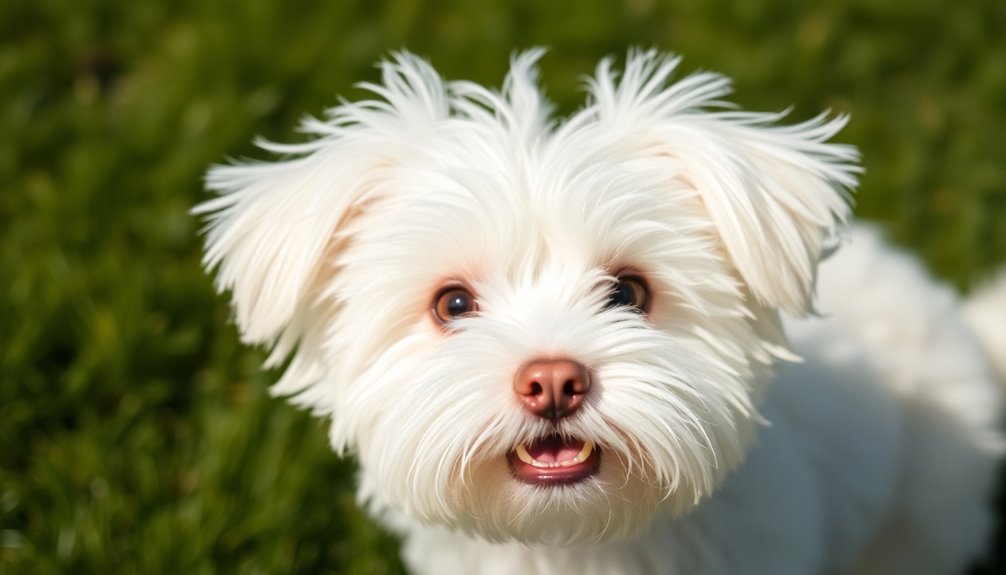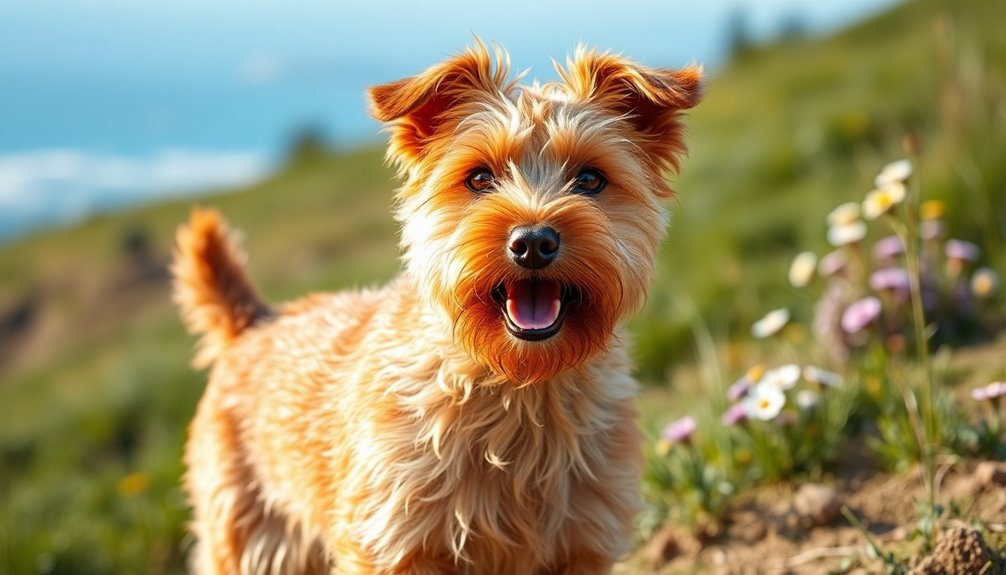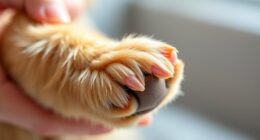The Coton de Tulear is a charming breed that stands 9 to 12 inches tall and weighs 8 to 13 pounds. With its fluffy, cotton-like coat and friendly attitude, this small dog makes a perfect companion. Known for being affectionate and intelligent, they're easy to train and adapt well to various living environments, including apartments. Their hypoallergenic coat is great for allergy sufferers, but it does need daily grooming. Enjoying daily exercise and mental stimulation, they thrive on social interaction. If you're curious about their royal heritage and care tips, there's much more to discover!
Key Takeaways
- Coton de Tulears are small, fluffy dogs with a non-shedding white coat, making them ideal for allergy sufferers.
- Known for their affectionate and playful temperament, they easily bond with families and individuals.
- This breed requires daily grooming to prevent matting, ensuring their fluffy coat stays healthy and beautiful.
- Coton de Tulears enjoy exercise and mental stimulation, making activities like walks and puzzle games essential for their wellbeing.
- Their sociable nature and adaptability make them excellent companions, thriving in both apartments and houses.
Introduction
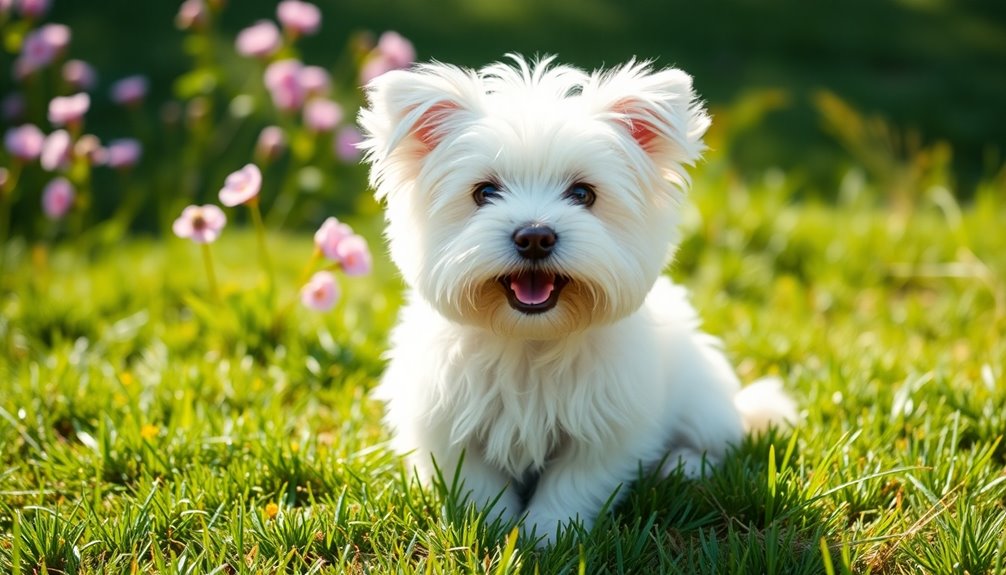
The Coton de Tulear is a charming small breed, typically standing between 9 to 12 inches tall and weighing 8 to 13 pounds. Known for its medium-to-long, fluffy coat that resembles cotton, this breed is often considered to have hair rather than fur. Traditionally, the Coton's coat is white, giving it an elegant appearance.
The body structure is moderate in length, featuring a well-developed chest and a strong, slightly arched back, complemented by small, arched feet.
When it comes to temperament, you'll find the Coton de Tulear to be affectionate and playful. This breed forms strong bonds with families and enjoys spending time with you and your loved ones. They're intelligent and eager to please, making training a breeze. While generally quiet, they can vocalize when they're having fun or alerting you to something. The breed is also known for its hypoallergenic coat, which means it produces less dander and is suitable for allergy sufferers.
Adaptable and curious, these dogs thrive in various living environments and love meeting new people. To keep their fluffy coats in top condition, daily brushing is a must, along with regular baths and grooming.
History and Origin
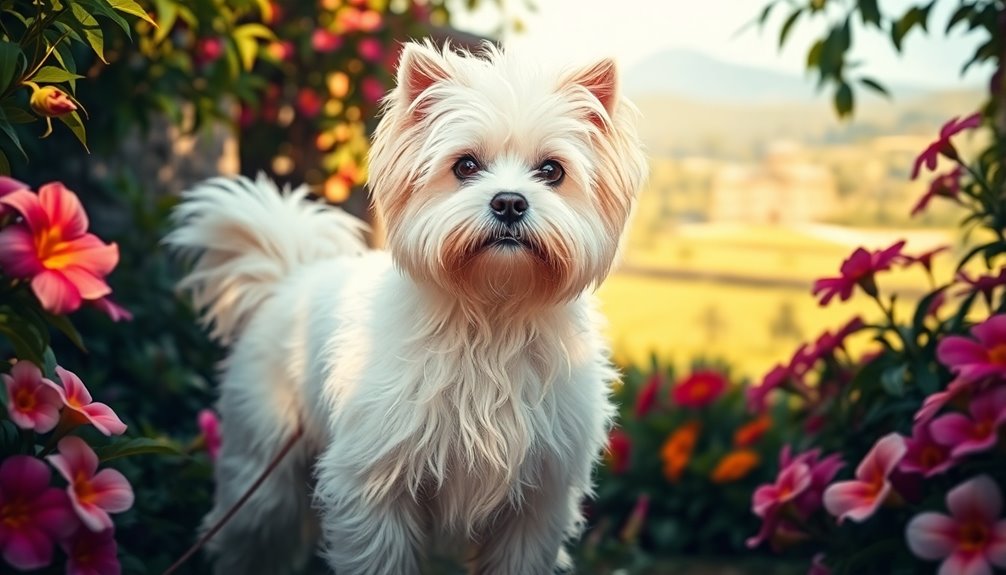
The Coton de Tulear has roots tracing back to Reunion Island, where sailors brought early ancestors in the 15th century. This breed quickly became a favored companion among Malagasy nobility, earning its title as the "Royal Dog of Madagascar." The breed is recognized as a national treasure in Madagascar, reflecting its significance in the country's cultural heritage.
Where and when the breed originated
Originating from the Bichon family of dogs, the Coton de Tulear boasts a rich history that traces back to ancient European breeds. Its ancestors, including the Barbet and the now-extinct Bichon Tenerife, were brought to the Canary Islands by Spanish sailors.
This Bichon Tenerife eventually made its way to the Indian Ocean Islands of Mauritius and Reunion during the 16th and 17th centuries. Here, the breed evolved into the Coton de Reunion, known for its long, cotton-like coat.
Seafarers later transported the Coton de Reunion to the port of Tulear in Madagascar, where it became the Coton de Tulear we know today. This breed developed in relative isolation, as ownership was restricted to Malagasy nobility and wealthy landowners.
The Merina ruling tribe and French colonists contributed to its refinement through selective breeding, incorporating traits from local dogs like the Morondava Hunting Dog. The Coton de Tulear was officially recognized in Madagascar on May 15, 1968, and it laid the foundation for its eventual global recognition, marking the start of its journey as a beloved companion breed. Additionally, the breed was designated as the Official Dog of Madagascar in recognition of its cultural significance.
Companion for Royalty
Known for its regal history, the Coton de Tulear served as a cherished companion to Madagascar's royal families, particularly the Merina tribal monarchy. Exclusively owned by noble Malagasy families, it was affectionately dubbed "The Royal Dog of Madagascar."
The ruling Merina strictly controlled its ownership, forbidding coastal tribesmen and non-nobles from having a Coton, which elevated its status among the elite. This exclusivity contributed to its prestigious reputation, making it a symbol of nobility and refinement.
Bred for the pure joy of companionship, the Coton de Tulear is known for its gentle and intelligent nature. It thrives on affection and attention, making it an ideal pet for families and homebodies alike. The breed is also known for its average lifespan of 15.7 years, demonstrating its resilience and adaptability.
Its intelligence and adaptability allow it to get along well with children and other pets, while its playful demeanor keeps it young at heart throughout its life.
The breed's significance didn't end with the royal families. During the French colonization in the 1700s, the Coton gained popularity among colonists, further solidifying its status.
In 1974, Madagascar honored this beloved breed on a postage stamp, marking its lasting cultural impact and royal legacy.
Physical Characteristics
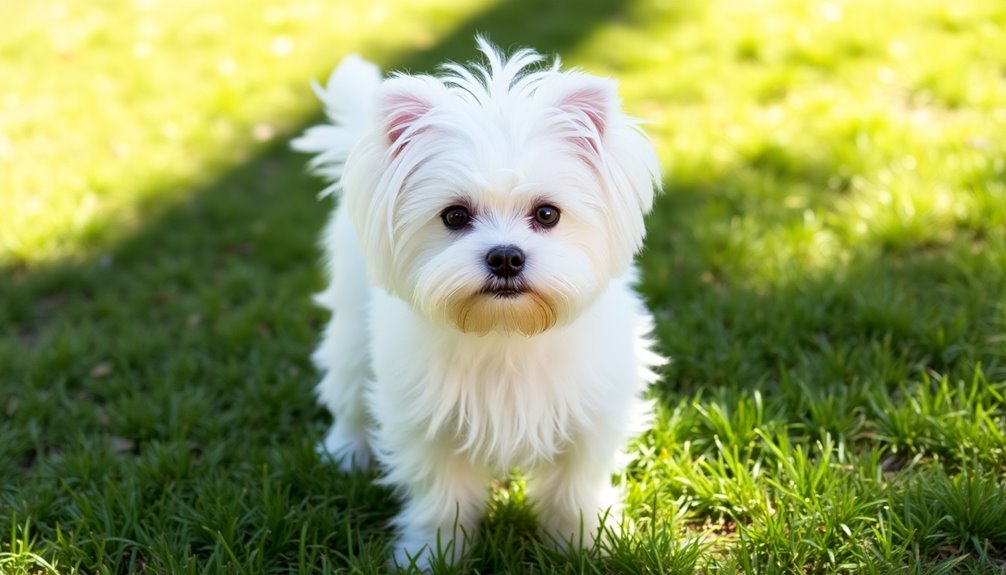
When you think of the Coton de Tulear, picture a small, fluffy companion with a soft, hypoallergenic coat that won't shed all over your home.
Males typically stand between 9.8 to 11.8 inches tall, while females are slightly smaller, making them perfect for both cuddling and companionship.
With their curly fur and charming demeanor, these dogs aren't just adorable; they're also a great choice for allergy sufferers. Their ideal height makes them well-suited for both apartment living and family homes.
Size, weight, and coat details
The Coton de Tulear is a small yet sturdy breed, standing between 9 to 11 inches tall, with some males reaching up to 12 inches. If you're considering one, be aware that the ideal weight for females ranges from 8 to 13 pounds, while males typically weigh between 9 and 15 pounds. Most Cotons average between 11 and 15 pounds, with a maximum weight limit of 18 pounds.
This breed has a body structure that's longer than its height, giving it a rectangular outline. Its chest is well-developed, reaching the elbow level, and the back is strong and slightly arched. You'll notice that its ribs are well-sprung and extend well back, while the loin is muscular but not overly long.
The Coton de Tulear's coat is medium to long, fluffy, and reminiscent of cotton, primarily appearing in white with possible grey, tan, black, or tri-colored markings. As a non-shedding breed, daily grooming is essential to prevent matting. In addition to its charming appearance, this breed is known for its hypoallergenic coat, making it suitable for allergy sufferers.
You'll find that the tail is low-set, tapering, and typically carried over the back when the dog is in motion.
Curly, Soft, Hypoallergenic Fur
Many dog lovers appreciate the Coton de Tulear for its remarkable fur, which features a soft, fluffy texture reminiscent of cotton. This breed boasts a dense coat that can be straight or slightly wavy, with an impressive length of about four inches all over its body. You'll find that puppies are particularly blessed with an even softer coat than adults, making them irresistible.
One of the standout qualities of the Coton de Tulear's fur is its hypoallergenic nature. This low-shedding coat produces less dander, a common allergen, and lacks an undercoat, which helps minimize shedding and flaking. While it's not completely hypoallergenic, it's certainly easier for mild allergy sufferers. Additionally, the Coton de Tulear is classified as hypoallergenic due to its fine hair coat, making it suitable for families with allergy sensitivities.
Be mindful, though—your Coton may lose some extra fur in the spring.
Grooming this breed requires regular brushing to maintain its softness and to prevent tangles, especially in areas like the neck and groin. Aim for daily brushing, particularly during coat changes.
You should also bathe your Coton every three to four weeks and ensure thorough drying afterward to keep mold and bacteria at bay.
Temperament and Personality
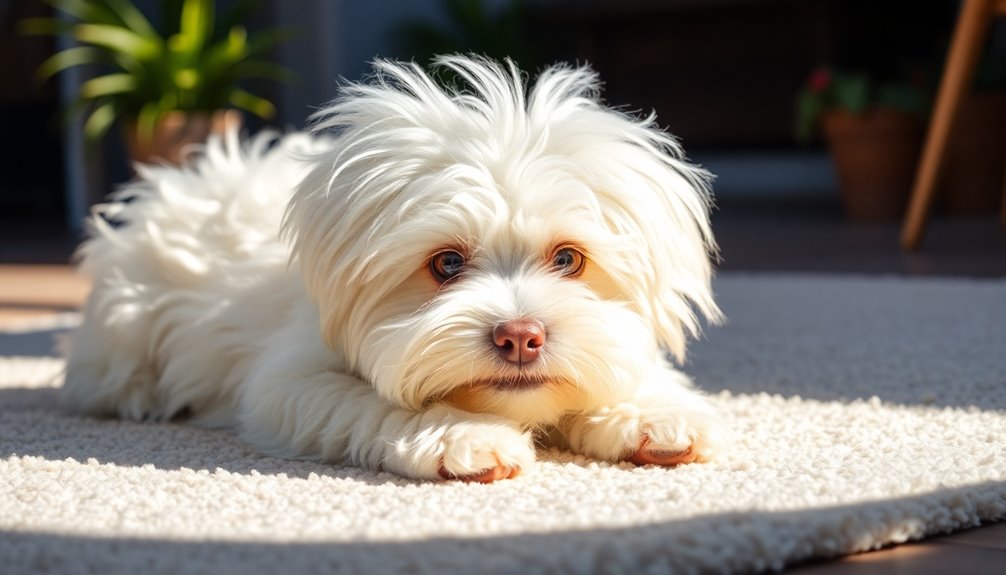
The Coton De Tulear is playful and sociable, making it a great companion for families, individuals, and other pets. You'll find them eager to join in on activities and thrive on human interaction. Their friendly demeanor ensures they'll fit seamlessly into your home, bringing joy and laughter wherever they go. With their high-energy needs, regular exercise is essential to keep them happy and healthy.
Playful and Sociable Demeanor
Embodying a playful spirit, Coton de Tulears thrive on interactive playtime, turning simple activities into joyful experiences. You'll find that your Coton enjoys games like fetch or playful wrestling sessions, making every moment fun. Despite their small size, they're surprisingly sturdy and can keep up with various activities, especially in the morning when their high energy levels shine through. Regular playtime isn't just enjoyable; it's essential for their overall health and wellness.
These dogs are incredibly sociable and form close bonds with their human families. They love your company and often follow you from room to room, eager to be involved. Highly social dogs like the Coton de Tulear thrive on human interaction, making their companionship even more fulfilling. Socialization from a young age is crucial to help them develop into well-rounded companions. By introducing them to new toys, engaging in dog sports, and encouraging interactions with other dogs and people, you'll enhance their sociable nature.
With their intelligence and eagerness to please, training your Coton is fairly straightforward, especially with positive reinforcement. Keep their minds engaged with mental stimulation through games and training exercises to ensure they remain happy and lively companions.
Suitability for families, individuals, or other pets
Coton de Tulears make excellent companions for families, individuals, and even other pets due to their affectionate nature and adaptability. They generally get along well with children, especially if you supervise interactions and introduce them properly. Their gentle demeanor allows them to form strong bonds with family members, making them patient and loving playmates for well-mannered kids. However, early socialization is crucial to prevent anxiety or behavioral issues.
For individuals, these dogs thrive in homes where they're not left alone for long periods. They need constant attention and affection, as they can develop separation anxiety if you're gone too much. Additionally, their friendly disposition makes them a delight in social settings, further enhancing their suitability as family pets.
Their small size and moderate energy level make them suitable for apartment living, but they do require daily grooming and interaction. When it comes to other pets, Cotons usually get along well, provided they've been properly introduced. Early exposure to various pets enhances their social skills, although they can be territorial if not socialized adequately.
With the right training, these charming dogs can even become excellent therapy companions, thriving in homes with multiple pets or family members.
Health and Lifespan
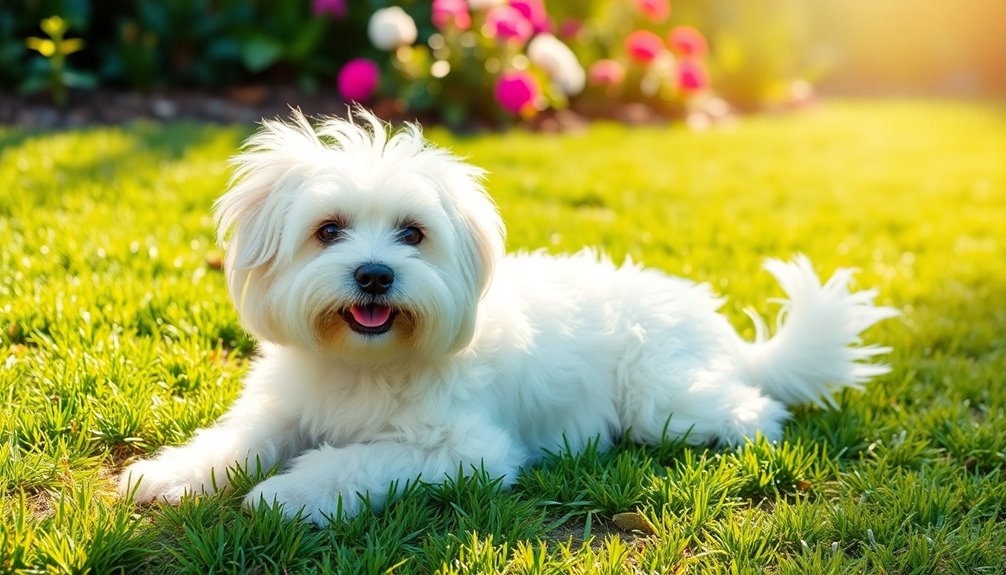
When it comes to the health and lifespan of your Coton De Tulear, understanding common health concerns is crucial. These dogs typically live between 14 to 16 years, but proper care can help them reach their maximum potential lifespan. Regular health tests for breeders, including elbow, hip, heart, and eye evaluations, can significantly reduce health risks and promote overall well-being.
Typical lifespan of the breed
With a typical lifespan ranging from 15 to 19 years, the Coton De Tulear is known for its longevity among dog breeds. While a UK study indicates an average life expectancy of 14.2 years, individual cases can vary, often falling between 13 and 14 years.
Generally, you can expect this breed to live anywhere from 14 to 16 years, depending on several factors.
Genetic factors play a significant role in your Coton's longevity, but you can positively influence it through proper care. Providing high-quality, protein-rich nutrition and ensuring regular exercise, like daily walks and playtime, are crucial for maintaining their health. Additionally, consider incorporating science-backed supplements into their diet to support their overall well-being.
Mental stimulation also matters, as it contributes to their overall well-being.
Regular grooming is essential to prevent matting, while daily dental care helps avoid tartar buildup. Annual veterinary check-ups for vaccinations and health assessments are vital.
Additionally, their adaptability to apartments or houses and need for social interaction can significantly impact their lifespan.
As your Coton ages, consider making lifestyle adjustments, including a balanced diet and joint supplements, to enhance their quality of life.
Common health concerns or genetic predispositions
Health concerns and genetic predispositions can significantly impact the Coton De Tulear's well-being and lifespan. One notable genetic disorder is Primary Hyperoxaluria (PH), which can lead to kidney failure due to crystal accumulation. Symptoms often appear early, around 3-4 weeks, and include lack of appetite and vomiting. Approximately 8.5% of Coton de Tulears from Finnish kennels are carriers of this condition. Additionally, genetic testing can help identify carriers and prevent the breeding of affected puppies.
Eye disorders, such as retinopathy, can also affect this breed. Symptoms typically surface between 3 and 4 months of age, and while the condition is nonprogressive, it can still impact visual health.
In addition to genetic issues, Cotons de Tulear face common health challenges like obesity, which can lead to joint problems and heart disease. Tracheal collapse and arthritis may arise, especially in overweight dogs. Hypoglycemia is another concern, manageable with proper care.
Skin allergies, triggered by environmental factors or food, can cause discomfort and require careful management. By understanding these common health concerns and genetic predispositions, you can be better prepared to maintain the health of your Coton De Tulear.
Tips for maintaining health and wellness
Maintaining the health and wellness of your Coton De Tulear goes hand in hand with understanding their specific needs. Start with daily brushing to prevent matting and tangling, paying special attention to their ears, legs, and elbows. Engaging them with educational toys can also provide mental stimulation while you groom them.
Regular ear cleaning is crucial, especially for those floppy ears, to avoid infections. Don't forget daily dental care to prevent tartar buildup and gum disease, and always ensure fresh water is available for hydration.
When it comes to nutrition, pick high-quality dog food with real meat as the primary ingredient, specifically formulated for small to medium-sized breeds. Follow feeding guidelines based on your pup's age, weight, and activity level, and be cautious not to overfeed, as obesity can lead to health issues. Additionally, be aware that Coton De Tulears are hypoallergenic dogs, making them suitable for allergy sufferers.
Your Coton needs at least 30 minutes of exercise daily, which can include walks, agility activities, and play sessions. Incorporate mental stimulation through puzzle toys and regular training to foster good behavior.
Lastly, prioritize early socialization with various people and environments to help them grow into well-adjusted adults. With these tips, you'll ensure a happy, healthy life for your furry friend!
Care Requirements
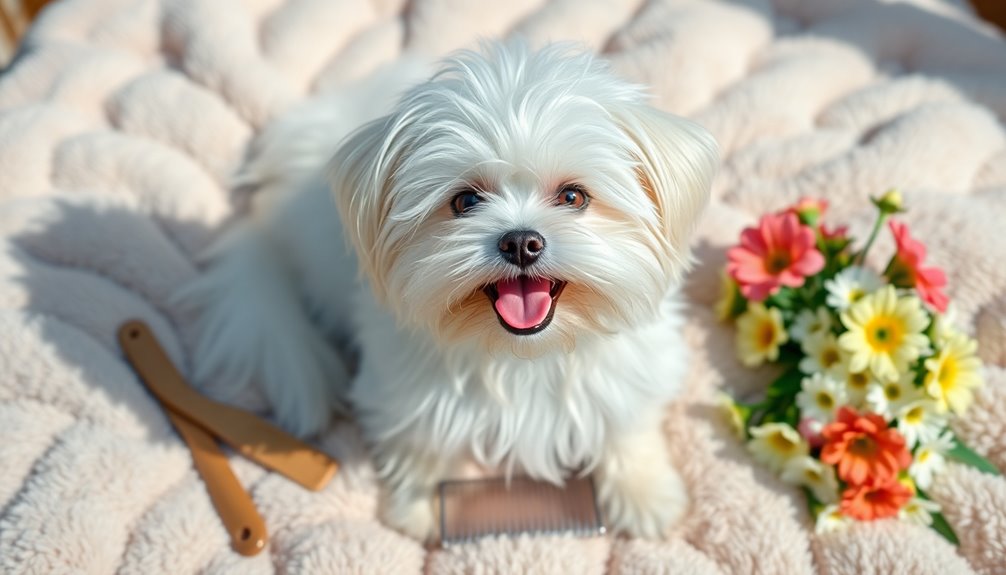
Caring for your Coton de Tulear involves regular brushing to keep their coat in top shape and prevent mats. To establish a positive grooming routine, it's essential to start early grooming as it helps your puppy acclimate to grooming tools and techniques. You'll also need to ensure they get enough exercise to match their playful energy levels. Finally, pay attention to their diet, as proper feeding plays a crucial role in their overall health and vitality.
Regular Brushing Required
Brushing your Coton de Tulear regularly is essential for keeping their beautiful coat in top condition. If your Coton has the standard long-haired coat, aim for daily brushing to prevent matting. For those with a shorter puppy cut, brushing 2 to 3 times a week should suffice, but be attentive to their needs.
During the coat-changing phase, daily brushing is crucial to manage mats, regardless of hair length.
Use a pin brush or slicker brush to effectively remove tangles and mats. Spraying a hydrating product before brushing helps prevent breakage. Start brushing from the undercoat, working upwards gently to avoid discomfort. It is also important to ensure that you use high-quality grooming tools to make the grooming process more effective and comfortable for your dog.
Pay extra attention to areas around the ears, legs, and underbelly, as these are prone to tangling.
Before bathing, tackle mats using a detangler and gently pull them apart with your fingers. Sectioning off mats and working them out in small parts can be effective.
Exercise requirements and energy levels
While Coton de Tulears don't require extensive exercise, they still need daily activity to stay healthy and happy. Aim for about 30 minutes to 1 hour of exercise each day, which can include daily walks. Their small size makes them suitable for cuddling, but they also enjoy active playtime in a securely fenced area; let them enjoy games like fetch or tug-of-war. These playful pups have a medium energy level and are always eager for a game, but they don't need constant stimulation. Additionally, engaging in intrinsic motivation can enhance your bond during exercise sessions.
Coton de Tulears are alert and active, making them great candidates for dog sports like obedience, rally, and agility. Moreover, these dogs are known for their affectionate nature, which can enhance the bonding experience during exercise sessions.
If you have a puppy, keep in mind that their exercise needs differ. Start with shorter play sessions of about 5 to 10 minutes per month of age, up to twice a day, and gradually increase this as they grow. Keep an eye on how your puppy handles exercise and consult your vet for tailored advice.
To prevent boredom and destructive behavior, incorporate puzzle toys or mental challenges alongside physical activities. Regular interaction is key to ensuring your Coton de Tulear remains engaged and happy.
Feeding tips and diet recommendations
A balanced diet is crucial for keeping your Coton de Tulear healthy and vibrant. Focus on high-quality protein sources like beef, chicken, turkey, lamb, duck, eggs, and fish to support their energy needs. Include balanced fats, both saturated and unsaturated, for optimal health. Carbohydrates from vegetables and fruits provide necessary fiber, prebiotics, and antioxidants.
For puppies, feed them 3-4 times a day until they're about 6 months old, then switch to twice daily. Adult Cotons should also be fed twice daily. Consistency in feeding helps control caloric and nutritional intake. Consider adding nutritional supplements like NuVet wafers and Wild Alaskan Salmon Oil for variety.
Choose high-quality, low-fat dog food specifically formulated for small breeds. While raw food diets can prevent obesity and other health issues, avoid kibble high in starchy carbs. Treats should be given sparingly, and you should always monitor their calorie intake to prevent overfeeding. Regular exercise is vital for maintaining a healthy weight in your Coton de Tulear.
Be cautious of toxic foods like chocolate and raisins, and opt for healthy snacks like baby carrots and apples in moderation.
Regular dental care is vital to prevent dental issues, ensuring your Coton stays happy and healthy.
Training and Socialization

When training your Coton De Tulear, you'll find they're quick to learn commands, making the process enjoyable for both of you. Gradually exposing them to new environments helps build their confidence and adaptability. Just keep in mind that they may experience separation anxiety during training, so it's important to approach each session with patience and care. Implementing positive reinforcement strategies can further enhance your training outcomes and strengthen your bond.
Quick to Learn Commands
Training your Coton de Tulear to learn commands is both rewarding and enjoyable. These dogs are quick learners, making it easy for you to teach essential commands like "Sit," "Come," and "Stay." Starting with these basics is crucial for establishing obedience and ensuring safety.
Use positive reinforcement to reward good behavior, which keeps your dog motivated and eager to learn. Clicker training can be particularly effective; the sound of the clicker marks desired behaviors, reinforcing them in your Coton's mind.
Keep training sessions short and fun, as Cotons can get bored easily. Aim for consistency in your commands, ensuring your furry friend knows what you expect. Additionally, remember that consistency and patience in your training methods will lead to more effective learning.
Incorporating commands like "Leave It" and "Lie Down" helps build on the foundational skills you've taught, enhancing your dog's training.
Gradual Exposure to New Environments
Gradual exposure to new environments is essential for your Coton de Tulear's development and confidence. Start by introducing your puppy to quiet, familiar areas like your home and backyard before venturing to busier places such as parks or pet-friendly stores. This approach helps prevent fear and anxiety.
Observe your dog's reactions and adjust based on their comfort level, ensuring that each experience is positive. Use familiar toys or games to engage your dog in these new surroundings, which helps build their confidence. Keep initial exposure sessions short, and reward calm behavior with praise or treats. Safe exposure is critical for promoting a positive mindset and reducing anxiety in your dog.
If your dog shows signs of discomfort, retreat to a quieter spot to help them relax. Monitor your dog's emotional responses and look for indicators of adaptability, like calm behavior and relaxed body language. If you notice stress signals, such as excessive panting or hiding, slow down the exposure pace.
Patience and consistency are key; building adaptability takes time. By gradually exposing your Coton de Tulear to new environments, you'll foster resilience and trust, setting the foundation for a well-adjusted, confident companion.
Separation Anxiety During Training
Building confidence through gradual exposure can significantly help in managing separation anxiety during training. Coton de Tulears thrive on companionship, so when left alone for too long, they can exhibit destructive behaviors. You might notice your pup chewing furniture or barking excessively when feeling lonely.
To combat this, use positive reinforcement training, rewarding your dog only after they successfully complete a task. This structured approach helps them understand their role and reduces anxiety. Establishing rules, boundaries, and limits is essential for helping them feel secure in their environment.
Incorporate mental stimulation into their routine with puzzle games or new tricks, which can build their self-esteem and keep them engaged. Consistency in your training methods is key, as it reinforces their learning and helps alleviate anxiety.
Early socialization is also crucial; exposing your Coton to various environments and people can prevent future territorial behavior and increase their adaptability.
If you're struggling, consider enrolling in a professional training program. Certified Separation Anxiety Trainers (CSAT) can offer tailored plans and support, using methods like systematic desensitization to help your dog feel secure when alone.
Ideal Living Environment
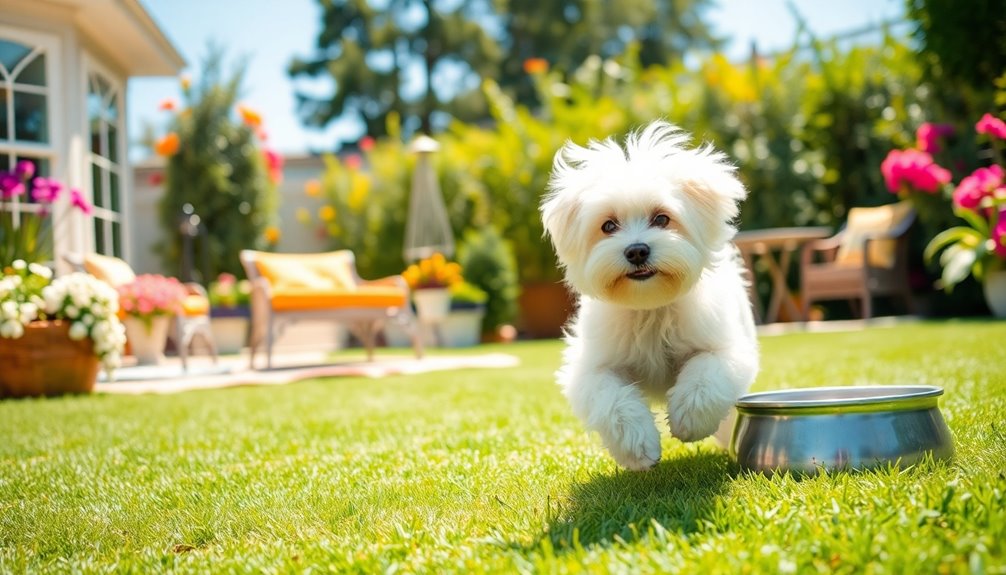
Coton De Tulears are perfect for urban apartment living, thanks to their small size and adaptability. They thrive in environments where they can stay close to you, so a cozy space is ideal. Just make sure to keep an eye on the temperature, as they tolerate mild conditions best. Their friendly and affectionate temperament makes them highly social companions that enjoy being around their families.
Urban Apartment Living
When considering a dog for urban apartment living, the Coton de Tulear stands out as an ideal companion. This breed thrives in smaller spaces like apartments and condos, making them perfect for city dwellers. They don't require a great deal of exercise, allowing you to balance work, life, and play without feeling overwhelmed.
Coton de Tulears adapt well to various environments and are comfortable with the normal sounds of city life. With proper training, they can adjust to street noise and neighborhood commotion, easing any anxiety you might've about living in a bustling area. Their hypoallergenic qualities make them particularly suitable for families with allergies, ensuring that everyone can enjoy their company.
These friendly pups are incredibly social and form strong bonds with family members, including kids and other pets. Their affectionate nature means they'll follow you around, seeking companionship. Plus, they're easy to train and eager to please, which helps in curbing unnecessary barking.
Just remember, they need regular grooming and shouldn't be left alone for long periods, as they can experience separation anxiety.
With a balanced routine of play and quiet time, your Coton de Tulear will thrive in your urban apartment, bringing joy and liveliness to your home.
Tolerates Mild Temperatures Best
For the Coton de Tulear, mild temperatures are ideal, allowing them to enjoy both indoor and outdoor activities comfortably. These dogs thrive in environments where the temperature is just right, avoiding extremes that may cause discomfort or health risks. While they can tolerate hot weather, you need to monitor them closely to prevent overheating. Make sure they've access to shaded areas or air conditioning, and limit their physical activity during peak heat hours. In colder conditions, they can handle the chill, but they won't want to stay outside for long. Additionally, their robust build aids in their ability to adapt to varying temperatures, making them a versatile companion. It's essential to provide them with shelter or clothing to protect them from extreme temperatures. During winter, keeping them indoors where it's warm will help maintain their comfort.
Coton De Tulear's Royal Roots
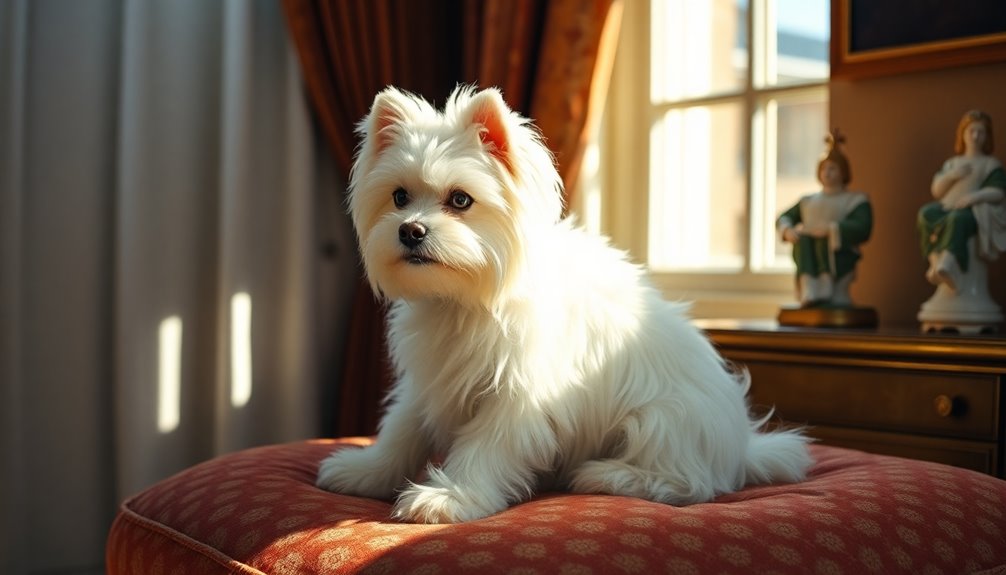
You might be surprised to learn that the Coton De Tulear has deep royal roots, once serving as a cherished companion to Queen Anne of Madagascar. This breed adapted beautifully to island living, thriving in its unique environment while earning the title of "The Royal Dog of Madagascar." Its exclusive ownership by nobility highlights its special status throughout history. The breed's popularity was further enhanced by its strong human connection, making it a beloved pet among kings and nobles.
Adapted to Island Living
The Coton De Tulear, with its regal heritage, is a breed that thrives in the unique environment of Madagascar. Originating from this island, it descended from dogs brought by pirates in the 16th and 17th centuries, blending the Tenerife dog with local breeds. This history shaped the Coton's ability to adapt to various climates, from tropical coastal areas to cooler inland rainforests and mountains.
The breed's fluffy, white coat isn't just adorable; it provides thermal insulation, allowing it to thrive in diverse weather conditions. With a robust and muscular build, the Coton demonstrates resilience and survival skills essential for life in Madagascar's rugged terrain. Additionally, their medium length, cotton-textured coat requires significant grooming, ensuring they remain looking their best.
You'll find that their medium-to-long, cotton-like coat is non-shedding and hypoallergenic, making them suitable for different living situations.
Their playful and affectionate nature means they bond closely with families, but they can show separation anxiety if left alone for too long. This adaptability is key, as Coton De Tulears require regular exercise and mental stimulation to stay happy and healthy.
With their keen intelligence, they can be trained easily, even if they might show some stubbornness at times.
Royal Companion to Queen Anne
Coton De Tulears, known as the "Royal Dog of Madagascar," have a rich history intertwined with nobility. Originating from Madagascar, these dogs were bred specifically for the companionship of the island's royal families. For centuries, commoners were prohibited from owning them, which helped maintain their exclusivity and purity.
Their ancestors likely arrived on pirate ships during the 16th and 17th centuries, establishing a unique lineage that remained isolated until French tourists discovered them in the 1960s.
Although they've no direct connection to Queen Anne, their status as luxury pets reflects the aristocratic values associated with royalty. Malagasy nobles valued Coton De Tulears for their companionship and distinct characteristics, treating them as symbols of nobility.
Strict controls enforced by the tribal monarchy ensured that these dogs didn't leave the island, preserving their lineage and attributes.
Today, their legacy continues as they form extraordinary bonds with humans. They're intelligent, easy to train, and excel in roles like therapy dogs. Their affectionate nature makes them ideal family pets, embodying the royal spirit they once represented in Madagascar.
Perfect for Apartment Dwellers?

If you live in an apartment and want a furry companion, a Coton De Tulear might be just right for you. Their small size and gentle nature make them perfect for first-time owners, and they adapt well to smaller spaces with enough exercise and mental stimulation. Plus, their grooming needs are manageable, allowing you to enjoy quality time together without a huge time commitment. Their affectionate and sociable nature also fosters strong family bonds, making them a delightful addition to any household.
Ideal for First-Time Owners
Looking for a dog that fits seamlessly into your apartment lifestyle? The Coton de Tulear might just be the perfect companion for you, especially if you're a first-time owner.
These dogs are incredibly adaptable, thriving in both cozy apartments and larger homes without stress. Their moderate activity level means they're content with short walks and indoor play, making them ideal for city living. Additionally, they have a lifespan of 14-16 years, which allows for a long and fulfilling companionship.
Coton de Tulears are known for their sociable and friendly nature. They form close bonds with their families, getting along well with kids, strangers, and other pets. Their affectionate personalities make them loyal companions who love spending time with you.
You won't feel overwhelmed trying to keep them entertained, as they enjoy energetic playtime without demanding excessive exercise.
Moreover, these intelligent dogs are easily trainable and respond well to basic commands. With consistent training, they can be left alone for short periods, easing any worries you may have about separation anxiety.
If you're looking for a loving and low-maintenance furry friend, the Coton de Tulear is an excellent choice for first-time dog owners living in apartments.
Grooming Needs and Time Commitment
How much time are you willing to dedicate to grooming your furry friend? The Coton de Tulear requires a consistent grooming routine, which can be quite time-consuming but rewarding.
You should brush their hair at least once a day to prevent matting and tangling, using a good quality pin brush and a slicker brush for those stubborn mats. Don't forget to tackle the sensitive areas like the ears and underbelly.
You'll also need to bathe your dog every two to four weeks with mild shampoo, ensuring you rinse thoroughly to avoid irritation. Additionally, keep in mind that their unique cotton-like coat is a result of a genetic mutation, making proper grooming even more essential.
Weekly ear cleaning and nail trimming are essential too; use nail clippers carefully and have styptic powder handy in case of any mishaps.
While you can manage routine grooming at home, consider professional grooming every six to eight weeks to keep their coat in tip-top shape.
This commitment may seem daunting, but with the right tools and techniques, you can create a bond with your Coton de Tulear, making grooming a pleasant experience for both of you.
Plus, their fluffy coat helps them adapt well to apartment living!
Frequently Asked Questions
How Much Do Coton De Tulears Typically Weigh?
When you're considering the weight of a dog, it's important to know that males typically weigh between 9-15 pounds, while females range from 8-13 pounds.
As they grow, expect variations: at 6 months, males usually weigh around 3.2-4.8 kg, and females about 2.8-4 kg.
By 12-13 months, they'll reach their full weight.
What Grooming Tools Are Best for Coton De Tulears?
For grooming your fluffy friend, you'll want to use several essential tools. A pin brush helps remove tangles, while a slicker brush is great for the undercoat.
Don't forget a wide-toothed comb for gentle detangling and a flea comb to keep the facial area clean.
Regularly trim nails with toe nail clippers, and consider using scissors for precise grooming around the paws.
Keeping these tools handy will ensure your pet looks their best!
Are Coton De Tulears Hypoallergenic?
Yes, Coton de Tulears are considered hypoallergenic because of their unique coat, which feels like hair rather than fur.
They shed minimally and produce low dander, making them a better choice for allergy sufferers.
However, keep in mind that no breed is completely allergy-free, and individual reactions can vary.
Regular grooming helps maintain their coat and reduce potential allergens, so you'll need to stay on top of their grooming routine.
How Long Do Coton De Tulears Usually Live?
Coton de Tulears usually live between 15 and 19 years, which is impressive compared to many other dog breeds.
You might find that some studies suggest an average of around 14.2 years. Individual lifespans can vary, with some living as little as 13 years or up to 16 years.
To help your Coton live a long, healthy life, ensure they get balanced nutrition, regular exercise, and routine vet check-ups to monitor their health.
Do Coton De Tulears Bark a Lot?
Coton de Tulears don't bark a lot, but their barking can vary based on their emotions and what they want to communicate.
You might notice them barking for protection, attention, or when they feel bored or anxious.
If you find their barking excessive, you can manage it through training, regular exercise, and understanding the reasons behind it.
With patience and consistent commands like "quiet," you can help reduce unnecessary barking.
Conclusion
In conclusion, the Coton de Tulear is a delightful companion, bringing joy with its fluffy coat and friendly demeanor. Its charming personality and adaptability make it perfect for various living situations, including apartments. With proper training, socialization, and health care, you'll enjoy a fulfilling bond with this affectionate breed for many years. If you're looking for a loving, playful addition to your family, the Coton de Tulear might just be the perfect fit for you!

